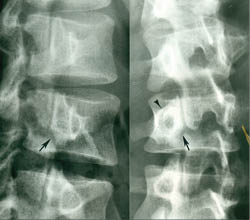Case History: This is a young college student who plays competitive basketball and is complaining of chronic mid lumbar spine pain. She hurts on hyperextension and has some relief on flexion. The specific diagnosis is?

Figure 1.
Diagnosis:
Unilateral Spondylolysis (pars defect) with contralateral sclerotic hypertrophy of the opposite pedicle.
Unilateral Spondylolysis
Spondylolysis may involve only one pars interarticularis of a single vertebra and may allow a 5 – 10% anterolisthesis. Unilateral spondylolysis may result in a compensatory stress hypertrophy of the contralateral pedicle in the region of the pars. (1) This compensatory hypertrophy is manifested radiographically by a contralateral, dense, sclerotic, enlarged pedicle and pars region. This appearance may mimic osteoid osteoma, osteoblastoma, or osteoblastic metastatic disease, which are common at this site. Agenesis of the pedicle may also show the same stress hypertrophy of the contralateral pedicle and pars region. The key differential sign is the presence of a unilateral pars defect. Regression of the compensatory bone changes may occur, should a stress fracture develop on the same side as the dense pedicle, resulting in bilateral spondylolysis and thereby equalizing the weight bearing and reducing the stress within the involved spinal motion segment. (1)
A MRI scan with STIR (fat suppression or fluid sensitive imaging) imaging will be positive at the active lesion demonstrating bone marrow edema (BME). That may be the unilateral pars defect or the contralateral sclerotic enlarged pedicle or both. If active, these areas would also be “hot” on a SPECT bone scan. These physiological studies drive the patient management. (See chapter 5 of Yochum & Rowe).
Reference:
1. Yochum TR, Rowe LJ: Essentials of Skeletal Radiology, 3rd ed., Lippincott, Williams & Wilkins, Philadelphia, PA, 2005.
Dr. Terry R. Yochum is a second generation chiropractor and a Cum Laude Graduate of National College of Chiropractic, where he subsequently completed his radiology residency. He is currently Director of the Rocky Mountain Chiropractic Radiological Center in Denver, Colorado, and Adjunct Professor of Radiology at the Southern California University of Health Sciences, as well as an instructor of skeletal radiology at the University of Colorado School of Medicine, Denver, CO. Dr. Yochum can be reached at 1-303-940-9400 or by e-mail at dcrad099@ aol.com
Dr. Alicia M. Yochum is a third generation chiropractor and 2011 Suma Cum Laude Graduate of Logan College of Chiropractic, as well as a Registered Nurse. She is starting her Radiology Residency at Logan College in April 2012. She can be reached at alicia.yochum@ gmail.com.

